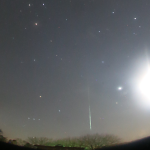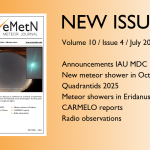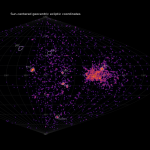EDMOND and SonotaCo net use UFO software commonly but their published data show slight differences. This paper gives the basic comparison between EDMOND and SonotaCo net results. The SonotaCo net data for 2007-2018 covers the whole year around except for bad weather conditions. The early EDMOND data covered only major shower periods. SonotaCo net favors faster meteors than EDMOND does and on the other hand SonotaCo net seems to perform weaker for slow meteors. The most important difference is the shower identification; both use different shower definition tables. It is recommended to know their characteristics to use them for shower search and orbit analyses.
1 Introduction
The European viDeo MeteOr Network Database (EDMOND) consists of the following regional networks:
- BOAM (Base des Observateurs Amateurs de Meteores, France);
- BosNet (Bosnia);
- CEMeNt (Central European Meteor Network, cross-border network of Czech and Slovak amateur observers);
- CMN (Croatian Meteor Network or HrvatskaMeteorskaMreza, Croatia);
- FMA (Fachgruppe Meteorastronomie, Switzerland);
- HMN (Hungarian Meteor Network or Magyar Hullocsillagok Egyesulet, Hungary);
- IMO VMN (IMO Video Meteor Network);
- MeteorsUA (Ukraine);
- IMTN (Italian amateur observers in Italian Meteor and TLE Network, Italy);
- NEMETODE (Network for Meteor Triangulation and Orbit Determination, United Kingdom);
- PFN (Polish Fireball Network or Pracownia Komet i Meteorow, PkiM, Poland);
- Stjerneskud (Danish all-sky fireball cameras network, Denmark);
- SVMN (Slovak Video Meteor Network, Slovakia),
- UKMON (UK Meteor Observation Network, United Kingdom).
We can get their results online (https://www.emeteornews.net/edmond/edmond/edmond-database/ and https://fmph.uniba.sk/en/microsites/daa/division-of-astronomy-and-astrophysics/research/meteors/edmond/). The results of SonotaCo net are published also on the web (http://sonotaco.jp/doc/SNM/).
The EDMOND data are based on UFO Orbit v2.41 and MetRec data has been converted by SonotaCo’s INF2MCSV. Both published data are, therefore, the same format and the comparison between them is very easy.
2 The data distributions around the year
Figure 1 shows the total recorded number of orbits for each bin of one degree in solar longitude with EDMOND 2001–2016 (top) and SonotaCo net 2007–2018 (bottom). The general views seem very similar, but the details are different between them, especially year by year.


Figure 1 – Recorded number of meteor orbits in function of the solar longitude for all years. EDMOND (top) and SonotaCo net (bottom).
SonotaCo net has published the results of all the year round for 2007 to 2018 but the early EDMOND years are limited to the observations of the major shower period. Figure 2 compares 2007 observations. Prior to 2007 EDMOND data are scarcer than in 2007. We recommend checking the observational year when making a survey on meteor shower activity (Table 1).
Table 1 – The annual totals of meteor orbits stored by EDMOND and SonotaCo net.
| Year | EDMOND | SonotaCo |
| 2001 | 251 | – |
| 2002 | 71 | – |
| 2003 | 113 | – |
| 2004 | 34 | – |
| 2005 | 82 | – |
| 2006 | 532 | – |
| 2007 | 2279 | 19274 |
| 2008 | 5583 | 19436 |
| 2009 | 8275 | 25940 |
| 2010 | 19618 | 25858 |
| 2011 | 36413 | 23772 |
| 2012 | 34732 | 27231 |
| 2013 | 41295 | 26514 |
| 2014 | 43546 | 22078 |
| 2015 | 57439 | 18723 |
| 2016 | 67426 | 22170 |
| 2017 | – | 26149 |
| 2018 | – | 27128 |
| Total | 317689 | 284273 |


Figure 2 – Recorded number of meteor orbits in function of the solar longitude for the year 2007 only. EDMOND (top) and SonotaCo net (bottom).
The differences in the weather conditions between Europe and Japan affect the profiles. The base line of the profile (excluding the shower peak) tends to rise around autumn for EDMOND an around winter for SonotaCo net (Figure 1).
The maximum occurs at the Perseids activity period for EDMOND and at the Geminids for SonotaCo net. Many of the EDMOND cameras are located at higher latitudes than those of SonotaCo net. However, the morning twilight hinders European observers a lot. The number of recorded Perseids in Europe is much higher than for Japan (see also ‘Shower classification’).
As observers are staying fixed on Earth, they cannot record the real shower maximum every year as we encounter the different parts of meteoroid streams every 0.25 degree in solar longitude year after year. This influences the value for the peak of the shower activity a lot.
3 Magnitude distribution
Magnitude distributions for meteors classified as sporadics by the definition of each network are shown in Figure 3; the absolute magnitude is used here because the early EDMOND data do not give the observed magnitude.
SonotaCo net data seems to display a slightly steeper ascent; with a magnitude ratio r = 3.48 for SonotaCo (mag. = –10 to –3) and r = 3.34 for EDMOND (mag. = –7 to –1). These magnitude ratios look good for sporadics.
If we extend these ratios to fainter magnitudes, we could get their observability on the magnitude separately (Table 2).
Can EDMOND systems record fainter meteors than SonotaCo’s? But, if we extend these ratios to the brighter range we see a strange situation. EDMOND has excessive bright meteors (Table 3).
Table 2 – Estimated perception coefficient.
| Magnitude | EDMOND | SonotaCo |
| –4 ~ –3 | – | 1.000 |
| –3 ~ –2 | – | 0.787 |
| –2 ~ –1 | 1.000 | 0.440 |
| –1 ~ 0 | 0.656 | 0.170 |
| 0 ~ +1 | 0.039 | 0.036 |
| +1 ~ +2 | 0.002 | 0.004 |
Table 3 – EDMOND’s super fireball rates.
| Magnitude | Estimated | Observed | Est./Obs. |
| –11 ~ –10 | 0.7 | 65 | 98.8 |
| –10 ~ –9 | 2.2 | 29 | 13.2 |
| –9 ~ –8 | 7.4 | 39 | 5.3 |
| –8 ~ –7 | 24.6 | 73 | 3.0 |
EDMOND has recorded bolides of the magnitudes –11 to –10 about one hundred times more frequently than expected by the magnitude ratio. Either the magnitude ratio for the fireball range (mag. = –7 to –1) should not be applied for super fireballs, or the magnitude distribution of EDMOND is affected by measuring problems? EDMOND data seem to be excessive in 0th magnitude meteors. ‘Super fireballs’ have been only observed in the interval 2007–2011. We cannot confirm that the perception of EDMOND is better than that of SonotaCo’s.

Figure 3 – Magnitude distributions.
4 Velocity distribution
Figure 4 shows the velocity distribution: the x-axis is geocentric velocity vg in km/s bin and the y-axis is the percentage of the total number of sporadics. It is clear that EDMOND can capture slower meteors and SonotaCo net faster ones. The reason for the difference is still unknown, though the difference of recording fainter meteors (positive magnitude) might affect this (Figure 5).

Figure 4 – Velocity distribution of sporadics.


Figure 5 – Magnitude distributions: vg = 20~40km/s (top) and vg = 50~70km/s (bottom).
5 Radiant density distribution along the elongation from the apex
The radiant density (radiant/square degree) shows the difference of these two systems (Figure 6). The difference in the elongation between 60 and 90 degree is caused by slower meteors (see former section), i.e. ANT. However, the dip in the SonotaCo net data near the apex is curious. This may be caused by the shower classification (see next section).

Figure 6 – Radiant density distributions.
6 Shower classification
The definition tables used to classify meteors are different for both networks. The definition table of EDMOND contains 621 IAUMDC showers and that of SonotaCo net has 311 IAUMDC showers with different entries together with the original list. SonotaCo net uses ‘all_shower_names’ file as their definition but the details of EDMOND’s are not clear. The author asked the EDMOND network to send the definition, but he did not receive an answer yet.
Table 4 shows the highly recognized meteor shower top 20 of each database based on their original classification. The shower code (_stream) is self-explanatory but _J5_bPi in SonotaCo net means NDA in the IAUMDC list. We note that some showers are missing in the list; _J8_SIA, _J8_ZCS and _J8_ZTA are not found in the SonotaCO list, and _J5_daD, _J5_bPi and _J5_Eri are not listed in EDMOND. The reason for the three missing showers in SonotaCo’s list is natural; they are less observed by EDMOND. But, the three EDMOND’s showers are not recognized in SonotaCo’s at all and, moreover, J8_ZCS is not listed in their definition table. It is very interesting that the ratios of sporadics and other showers are quite different. It is necessary to investigate what causes these differences.
7 Capricornids and Leonids
It is interesting to compare the Capricornids with the Leonids because of the difference in observability of the velocity between EDMOND and SonotaCo net.
Table 4 – Shower classification top 20.
| EDMOND
_stream |
% | SonotaCo
_stream |
% |
| _J8_PER | 14.17 | _J5_Gem | 8.95 |
| _J8_GEM | 6.07 | _J5_Per | 6.18 |
| _J8_ORI | 2.46 | _J5_Ori | 4.42 |
| _J8_STA | 1.98 | _J5_Com | 1.87 |
| _J8_NTA | 1.27 | _J5_sTa | 1.86 |
| _J8_COM | 0.92 | _J5_Hyd | 1.53 |
| _J8_SIA | 0.92 | _J5_Leo | 1.39 |
| _J8_HYD | 0.91 | _J5_nTa | 1.38 |
| _J8_QUA | 0.85 | _J5_etA | 0.97 |
| _J8_ZCS | 0.82 | _J5_sdA | 0.87 |
| _J8_LYR | 0.7 | _J5_Qua | 0.85 |
| _J8_CAP | 0.66 | _J5_daD | 0.81 |
| _J8_KCG | 0.58 | _J5_noO | 0.51 |
| _J8_LEO | 0.55 | _J5_Mon | 0.42 |
| _J8_SPE | 0.54 | _J5_Lyr | 0.4 |
| _J8_ETA | 0.43 | _J5_Cap | 0.38 |
| _J8_SDA | 0.38 | _J5_sPe | 0.35 |
| _J8_ZTA | 0.38 | _J5_bPi | 0.27 |
| _J8_NOO | 0.34 | _J5_Eri | 0.23 |
| _J8_Mon | 0.3 | _J5_kCg | 0.22 |
| others | 20.35 | others | 4.67 |
| _spo | 44.41 | _spo | 61.48 |
Figure 7 shows the difference clearly between the activity profiles of the Capricornids and the Leonids. The slower meteor shower, Capricornids, is twice as strong recorded in EDMOND compared to SonotaCo net, while the faster Leonids are twice as strong in SonotaCo net compared to EDMOND. These results are mainly influenced by weather conditions; the early Capricornids are hindered by the Japanese rainy season. However, the difference is not fully explained by the weather, because the late Capricornids are not observed by SonotaCo net with the same strength.
On the contrary, Leonids are abundant in SonotaCo net data. The difference in the weather condition is not enough to explain for the discrepancy in this case. The most probable answer for these different observabilities is the disparity of the treatment/recognition of fainter (positive magnitude) meteors in slower/faster velocity.
We can present one more reason for the difference. The difference in the shower definition table has a strong effect. EDMOND limits the activity period shorter than SonotaCo’s (Figure 7). Figure 8 and 9 suggest the difference in the table on the extent and the shift of the showers, although this explanation is not fully explanatory. These four maps are drawn in the azimuthal equidistant projection in ecliptic coordinates; the line λ – λʘ = 180 (Figure 8) or 272 (Figure 9) runs along the y-axis. These maps allow us to show that the radiant shift is slower than in the ordinary (α, δ) coordinates as well as the radiant distribution. The difference in the extent and the shift looks not so large for explaining the discrepancy.


Figure 7 – Activity profiles: Capricornids (top) and Leonids (bottom).


Figure 8 – Radiant distribution of the Capricornids centered at (λ – λʘ, β) = (180°, 10°).


Figure 9 – Radiant distribution of Leonids centered at (λ – λʘ, β) = (272°, 10°).
8 Conclusions
EDMOND and SonotaCo net data are not completely equal. The observability in function of the velocity and the shower definition table are different. We should be cautious when we search meteor showers combining both datasets.






I TRIED TO GIVE THIS FULL STAR RATING BY CLICKING FAR RIGHT OF THE RATING STARS BUT INSTEAD IT JUST GAVE ONE STAR AND WILL NOT LET ME AMEND IT!
THIS IS A SERIOUS INJUSTICE, THIS IS A VERY GOOD ARTICLE AND THE GRAPHS HAVE IMPORTANCE IN MUCH WIDER CONTEXT RELATIVE TO THE TWO DATASETS, NOT JUST IN THE CONTEXT OF THE ARTICLE. EITHER WIPE THE RATING I TRIED TO GIVE OR FIX IT TO FULL STARS RATING!!! PLEASE.